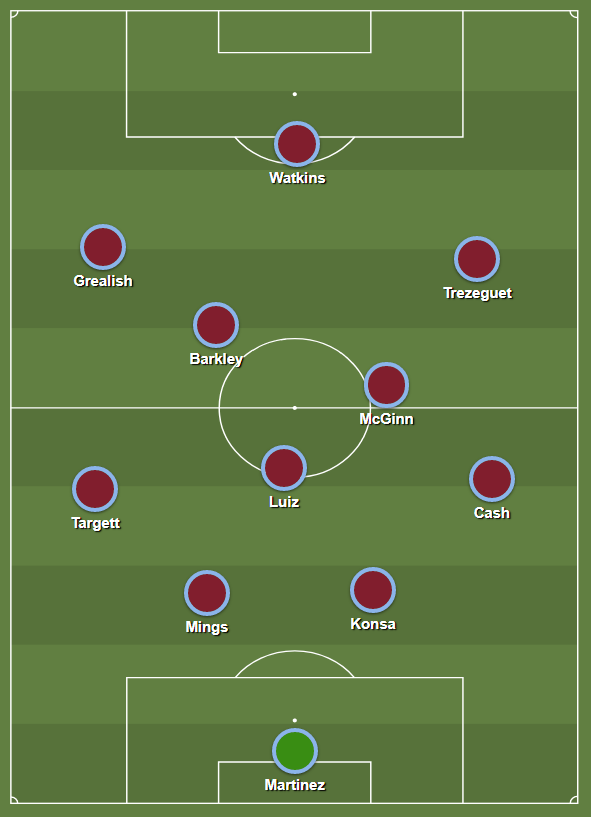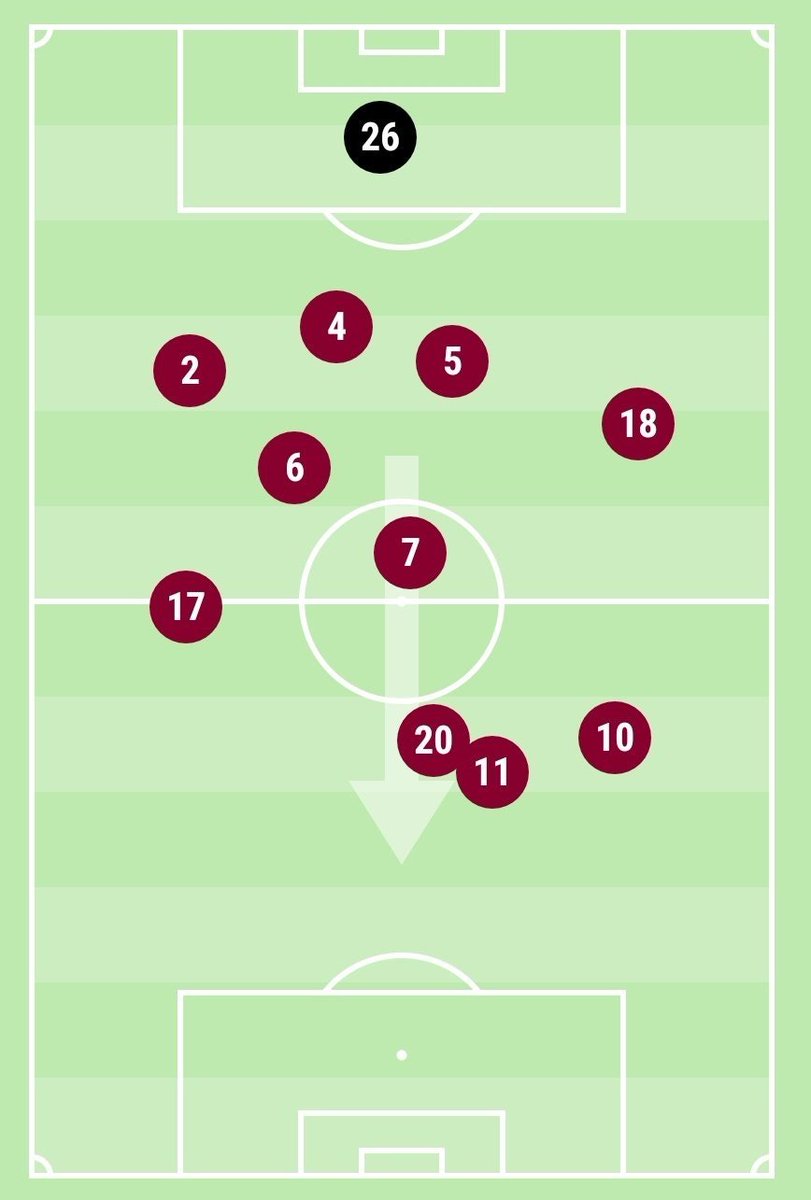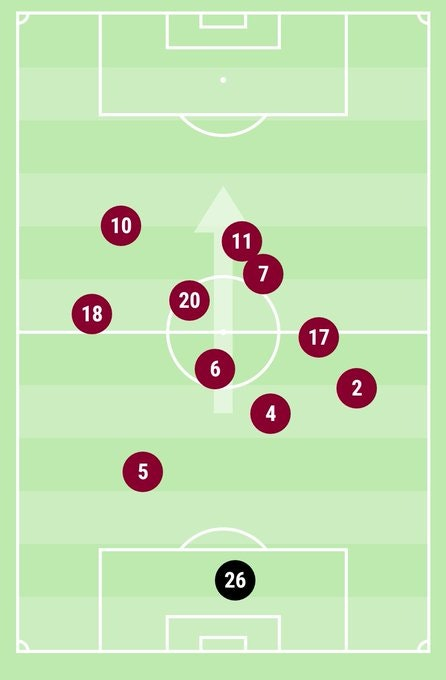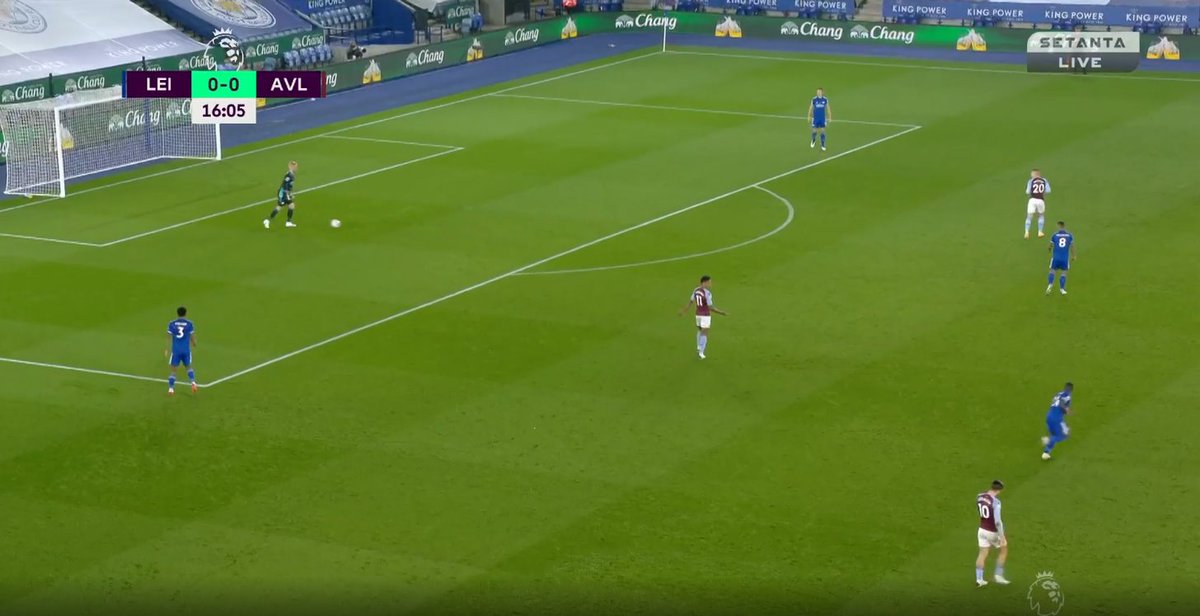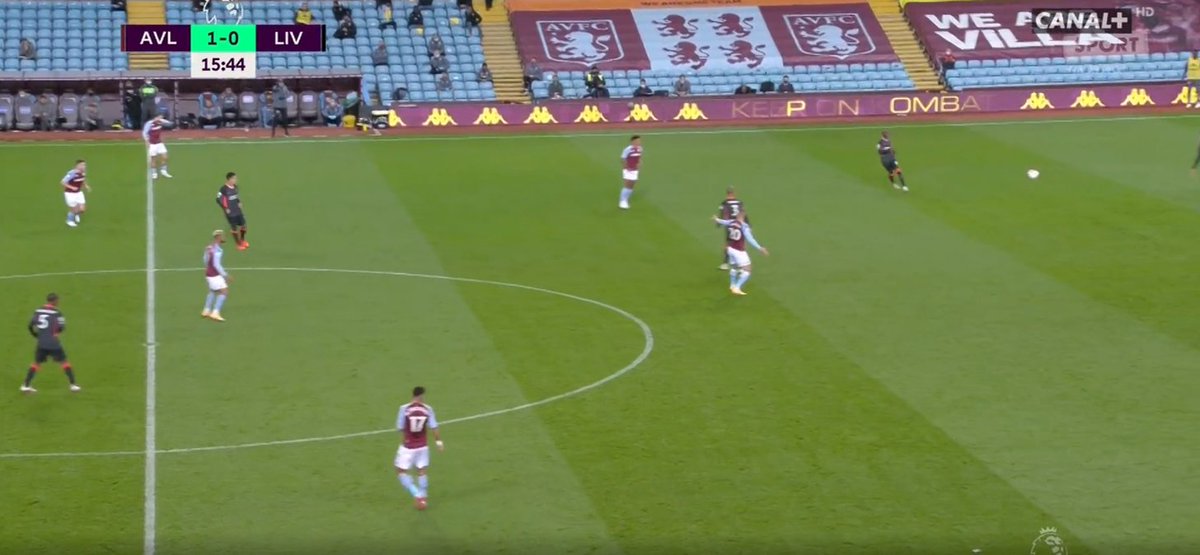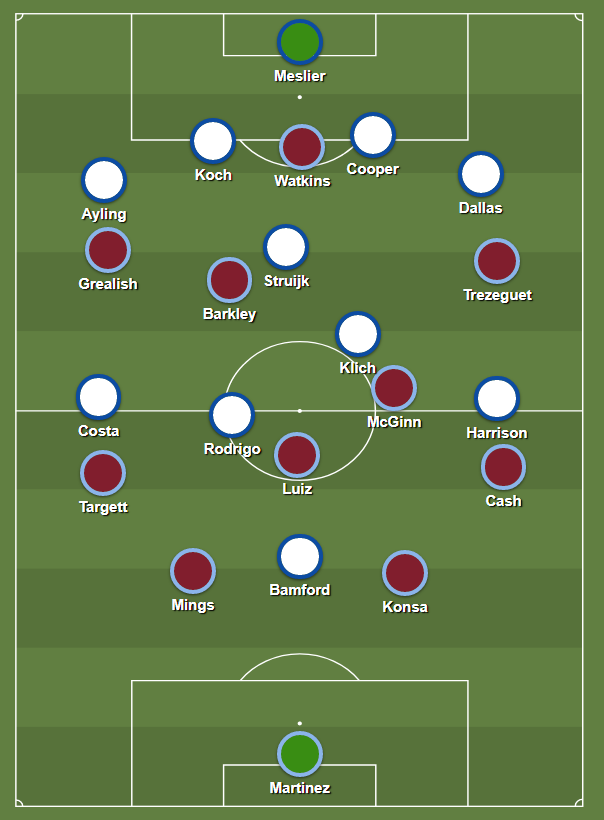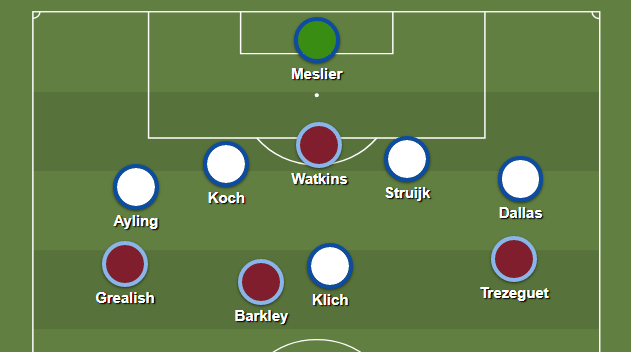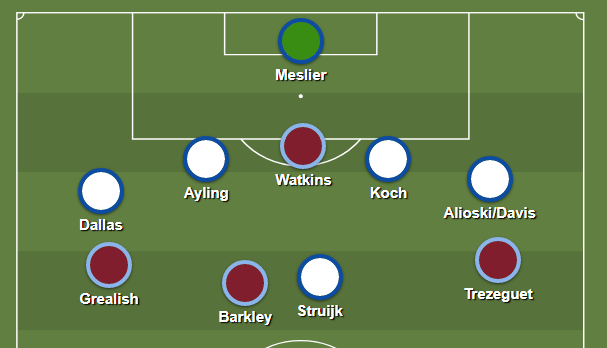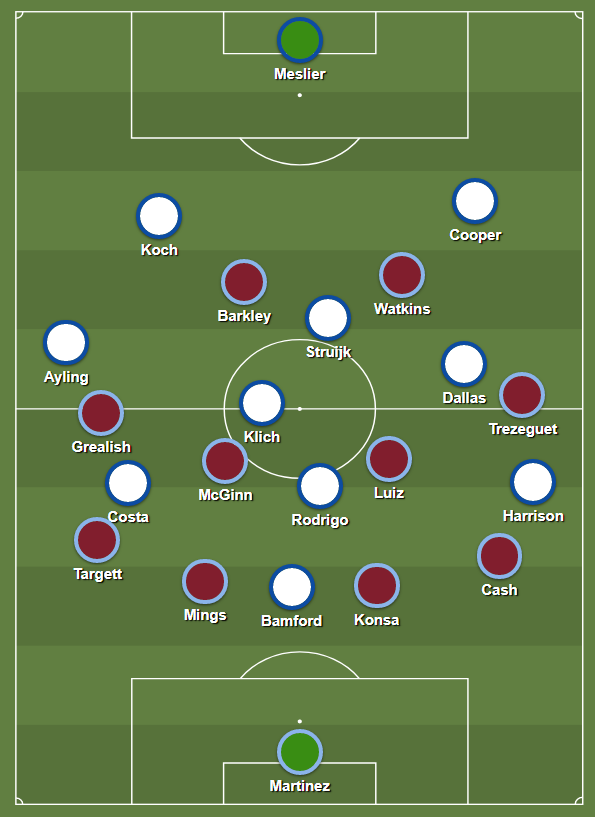Some tactical thoughts ahead of #lufc’s visit to Birmingham on Friday night: [thread]
It’s pretty tricky to assess where Aston Villa are at so far this season. Of course, four games of data is never enough.
But when those games include 80 minutes against Sheffield United with a man advantage and a Liverpool game that seems a total outlier, then it’s even more tricky to assess.
One thing is for certain: Villa are running slightly hot at both ends. In their four games, they’ve put up 7.2 xG per StatsBomb which has translated into 12 goals. That’s quite the overperformance.
At the other end, Villa have the best defence in the league. They have conceded 2 goals from 3.9 xG, both of which are good enough to put them at the top of the table from a defensive point of view.
Comparing them to Leeds (per 90 mins, of course, to account for Leeds’ extra game), Villa are a pretty ominous prospect:
looking at their xG differential (the difference between the average xG they’re putting up per 90 and the average xG they are conceding (xGA)), Villa are currently at +0.83 to Leeds’ -0.33.
Obviously, sample size. But so far in this short season, Villa have been creating better quality chances than they have been conceding. Leeds, however, have not.
At this point, it would be tempting to say that Leeds have played against Manchester City and Liverpool, but even then, Villa have played City and Leicester - hardly pushover prospects.
And the other two sides they have faced - Fulham and Sheffield United - are teams that Leeds have played too.
In short: Villa are a team who should be taken very seriously.
This season, though, we’ve seen some flexibility. Here are the average positions versus Liverpool and then versus Leicester:
As you can see, against Liverpool, Villa adopted a structure which is much closer to a 4-2-3-1 (which actually became a 4-4-2 out of possession), with Ross Barkley pushing up closer to Ollie Watkins and then helping him out in the press.
John McGinn then dropped deeper into a double pivot with Douglas Luiz.
Against Leicester, the structure looks much closer to a 4-3-3 (albeit with Trezeguet dropping very deep on the right-hand side no doubt to cover Harvey Barnes).
When looking at average position charts, though, it’s important to remember that these are generally based off player touches and so, largely, reflect the teams “in possession” structure.
For example, off the ball vs Leicester, Villa still adopted a 4-4-2 structure with Barkley sitting alongside Watkins:
Why do these two average position maps look so different? Well, if you look at the possession stats for the two games, versus Liverpool, Villa only managed 31% possession. Against Leicester, they matched them 50-50.
This means that Villa would have been in their defensive structure much more against Liverpool (understandably) and this skews the average position map towards their defensive set-up.
Villa’s defensive set-up is really interesting. At times last season, Villa went through the standard problem that promoted teams go through: how do you go from being a favourite to an underdog?
(c.f. Leeds United this season - although I think we’re probably doing a better job than Villa last season)
How do you go from being a largely attacking team to having to go through long spells absorbing pressure?
Through their time in the Premier League, Villa have become increasingly defence-minded. This has manifest in a number of ways:
Jack Grealish has been moved from an 8 position to a wide forward in a front three. Grealish is obviously the creative fulcrum in the team. You want to get him into advanced areas. If you’re playing him as an 8, then in defensive transition, you have a problem.
Now, with Grealish as a wide forward with a licence to roam, and with Douglas Luiz and John McGinn in the middle, Villa look much more solid in transition.
That doesn’t mean to say that Grealish isn’t defensively minded. On Friday, expect to see him deep in his own half, often just off the corner of his own box.
Dean Smith has his wingers drop in deep to help out defensively. Upon losing possession in the opponent’s half, Villa will press high to give their midfield chance to regroup but, if they don’t win the ball, will drop into a mid-block.
This means they will adopt a defensive structure which is zonally oriented and will wait for the opposition to bring the ball to a certain point—usually, the halfway line roughly speaking—before pressing.
Villa are happy to let Liverpool have possession. Their midfield two—McGinn and Luiz— take up central positions and the wide forwards—Grealish and Trezeguet—drop deep and flank them either side.
Barkley pushes up to help Watkins pressure the opposition CBs if they look to move the ball centrally.
Approaching the game in this way, Villa are able to compact space a lot better than teams who employ a high press. This means that their back line is under much less pressure from counter-attacks and, as we noted at the beginning of this thread, that has suited them well.
Going forward, Villa’s approach is simple enough: attack wide areas in transition, look to find Watkins and, if possible, get the ball to Jack Grealish.
Grealish is so strong on the ball that he can do two things:
The first is to win fouls in and around the box. Whatever else you think about Jack Grealish, he is an elite foul winner and this is *not* because he is a diver.
Rather, it’s a combination of his ability to resist pressing and the realisation by opponents that they can’t let him in the box.
On top of this: Grealish has the second most touches in opposition penalty boxes so far this season just behind Mohamed Salah who has played 90 mins more. He’s probably the best ball carrier in the Premier League and so much of Villa’s creativity comes through him.
When it comes to the match on Friday, Leeds’ task will involve stopping Grealish and looking to work through Villa’s mid-block.
When it comes to the defence, we’re still unsure as to how Leeds will line up. Assuming a best-case scenario:
Although Leeds fans like to wax lyrical about how Kalvin Phillips kept Grealish quiet in 18/19, Grealish has now moved wide and will become the responsibility of Luke Ayling.
With Robin Koch largely playing as the libero (the spare man at the back), expect to see him keeping close to Ayling to help out with Grealish.
…but let’s not think about that for now.
Positional play—the style of football Marcelo Bielsa uses where it is about the manipulation of space and creating overloads—was originally designed to exploit the structures of a 4-4-2 system: the rigid lines and the spaces that open out between them.
Off the back of a game against Wolves where they set up in a low block and shut down any space (and there is no one better at that in the Premier League than Wolves), the question here will be how much space will Villa leave to be exploited?
There is the possibility that Villa might fall into a 4-5-1 formation out of possession, keeping Barkley more central to give an extra body in midfield but, as we saw in the Wolves game, in possession, Leeds are happy to vacate the central area and focus on the wings.
This will be a fun game from a tactical point of view. The mid-block is a different challenge from the ones we have faced so far: high press (Liverpool, City, Fulham) and low block (Sheffield United and Wolves).
After surviving a scare last season, Villa have spent money and spent it well. Their team is well-rounded, young and has a tactical function. This is where Leeds will want to be at the beginning of next season.
For now, though, the task is to keep Grealish quiet and play through the mid-block.
If you prefer this in blog form (you can also sub to the newsletter here which will give you these previews direct into your inbox): https://allstatsarentwe.substack.com/p/aston-villa-vs-leeds-united-a-tactical">https://allstatsarentwe.substack.com/p/aston-v...
How about an audio version? https://pod.fo/e/a2954 ">https://pod.fo/e/a2954&q...
We& #39;ve also just put out an exciting bonus podcast as well as a Wolves review video analysis on our Patreon channel: http://www.patreon.com/allstatsarentwe ">https://www.patreon.com/allstatsa...

 Read on Twitter
Read on Twitter